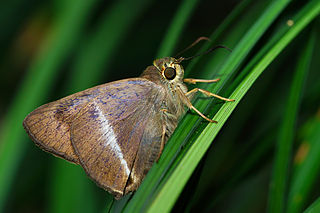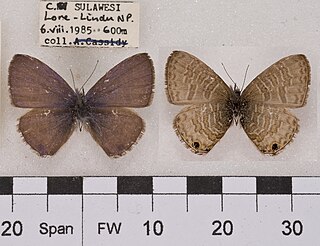
Hasora taminatus, the white banded awl, is a butterfly belonging to the family Hesperiidae, which is found in Asia.

Charaxes solon, the black rajah, is a butterfly species found in tropical Asia. It belongs to the Charaxinae in the brush-footed butterfly family (Nymphalidae).

Bindahara phocides, the plane, is a small butterfly found Indomalayan and Australasian realms that belongs to the lycaenids or blues family.

Cheritra freja, the common imperial, is a small butterfly found in India, Myanmar, Malaysia and Sri Lanka that belongs to the gossamer-winged butterflies family (Lycaenidae).

Spalgis epius, commonly known as the apefly, is a small species of butterfly found in the Indomalayan realm that belongs to the lycaenids or blues family. It gets its name from the supposed resemblance of its pupa to the face of an ape.

Jamides alecto, the metallic cerulean, is a small species of butterfly found in the Indomalayan realm but which crosses the Wallace line into the Australasian realm (Celebes). It belongs to the lycaenids or blues family.

Jamides caerulea, the royal cerulean, is a small butterfly that belongs to the lycaenids or blues family. It was described by Herbert Druce in 1873. It is found in the Indomalayan realm.

Heliophorus epicles, commonly known as the purple sapphire, is a species of lycaenid or blue butterfly found in Asia. The species was first described by Jean Baptiste Godart in 1823.

Euaspa milionia, the water hairstreak, is a small butterfly found in India, Nepal and Taiwan that belongs to the lycaenids or blues family.

Nacaduba angusta, the white lineblue, is a lycaenid butterfly found in South Asia. The species was first described by Herbert Druce in 1873.

Prosotas nora, the common lineblue, is a species of lycaenid butterfly found in Asia to Australia. The species was first described by Rudolf Felder in 1860.

Prosotas noreia, the white-tipped lineblue, is a species of lycaenid butterfly found in South Asia and Java.

Prosotas aluta, the banded lineblue, is a species of blue butterfly (Lycaenidae) found in Asia. The species was first described by Herbert Druce in 1873.
Prosotas dilata is a species of lineblue belonging to the blue butterfly family (Lycaenidae). The butterfly is found on the Nicobar Islands of India. It is now considered as a subspecies of the common lineblue.

Prosotas lutea or Brown Lineblue is a species of blue (Lycaenidae) butterfly found in Asia.

Prosotas pia, the margined lineblue, is a species of blue (Lycaenidae) butterfly found in Asia.

Baspa melampus, the Indian red flash is a species of blue (Lycaenidae) butterfly found in South-East Asia.

Pratapa icetoides, the blue royal, is a species of blue butterfly (Lycaenidae) found in the Indomalayan realm.

Prosotas is a genus of butterflies in the family Lycaenidae erected by Hamilton Herbert Druce in 1891. The species of this genus are found on New Guinea in the Australasian realm and the Indomalayan realm. An overview is provided by Hsu and Yen.

Prosotas gracilis or The Dark-based Lineblue is a butterfly in the family Lycaenidae. It was described by Julius Röber in 1886. It is found in the Indomalayan realm.




























